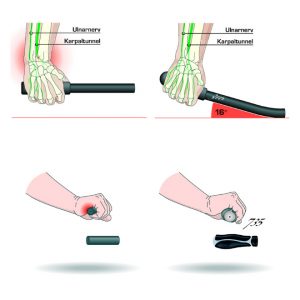
What makes us unique?
The combination of technology, systemic process knowledge, implementation strength and our own in-house software development. The methodical overcoming of the old world’s balance sheet thinking and the transformation into digital, data-driven and networked business models of the future.
How and what is measured?
We recommend that you have your bike adjusted as precisely as possible to your bicycle dealer, because first and foremost, the ergonomic setting of your bicycle is based on the correct analysis of your biometric data and the desired application. An optimal bicycle body adjustment improves the power transmission and reduces health risks.
saddle height
The saddle height is always set as the first point. It is measured from the center of the crank bolt to the top edge of the saddle or, with the ergonomic step saddle, to the top of the step. Saddle height is measured with the Bike Adjustment Device.
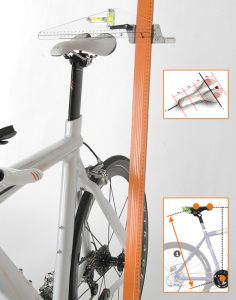
saddle offset
The saddle offset (saddle position) is crucial for the good feeling when pedaling and the power transmission. It is measured from the vertical through the bottom bracket to the saddle nose. The saddle offset determines the angle between the force acting on the pedal and the pedal crank arm. This angle must be optimized for the entire turn of the crank (360 degrees). The saddle offset is measured with the Adjustment Device (Bike Adjustment Device).
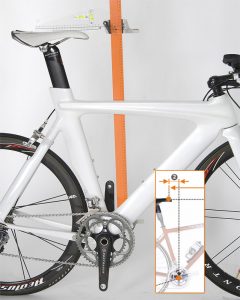
distance saddle – handlebar
The distance between the saddle and the handlebar depends on the length of the upper body and the posture. It is measured from the saddle nose up to the position of the handlebar, where you reach (on the road bike) or up to the top link position (MTB with straight handlebar). This distance often determines the length of the bicycle frame. The distance between the saddle and the handlebar is measured with the Adjustment Device (Bike Adjustment Device) or calculated with the top tube calculator if the frame is only available as geometry information from the catalog.
handlebar level
The handlebar level is expressed in relation to the saddle. Here there is a large tolerance field, since only three principal back positions (comfortable, moderate, sporty) are inquired. In reality, there are still many positions in between. The three seating positions are always related to the selected bicycle category. The handlebar level is measured with the Adjustment Device (Bike Adjustment Device).
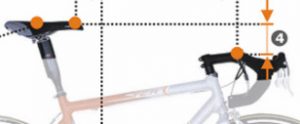
frame height
The distance between the saddle and the handlebar depends on the length of the upper body and the posture. It is measured from the saddle nose up to the position of the handlebar, where you reach (on the road bike) or up to the top link position (MTB with straight handlebar). This distance often determines the length of the bicycle frame. The distance between the saddle and the handlebar is measured with the Adjustment Device (Bike Adjustment Device) or calculated with the top tube calculator if the frame is only available as geometry information from the catalog.
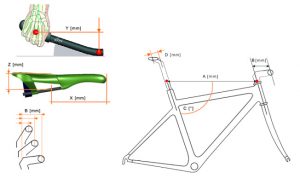
crank length
A longer crank basically means more torque, which can be transferred to the bottom bracket axle. The jump from 175 mm to 177.5 mm means an increase in torque of approx. 1.5%. Now you might think that the longer the crank, the better the efficiency of the driver. In principle, that’s the way it is. However, one must not forget the motor skills of the cyclist and his leg length. The mountain bike is still the ground clearance added. Therefore, only crank lengths of max. 175 mm offered. The standard crank length for trekking and city bikes is 170 mm, because the efficiency is less important than comfort. For racing cyclists with performance-oriented ambitions special assignments apply.
sitting posture
The ergonomics of every cyclist is different. So z. As the ergonomics of the city cyclist comfortable seating, good overview of the traffic and fast getting on and off at the traffic lights. In comparison, the ergonomics of the racing cyclist is streamlined sitting, high cadence and optimum power / performance ratio.
The bicycle saddle has to fit like a shoe.
Since each person is individually built, a well-developed system is needed, e.g. the distance between the ischial tuberosities, the back angle when riding a bicycle and the indication of existing problems. Body Scanning CRM enables an exact and application-specific adjustment of the saddle ergonomics.
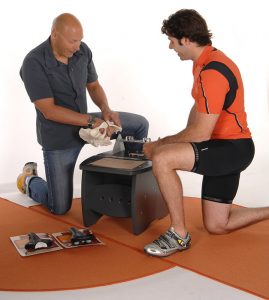
Anatomy and usage
Not only is the distance between the ischial tuberosities of interest for determining the correct dimensions of the bicycle saddle. Also, the back tilt, which can vary depending on the type of bicycle and type of use, is crucial here.
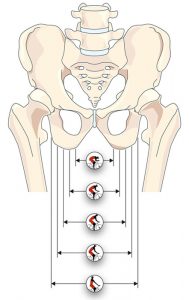
Pressure distribution on the saddle
When sitting on the bicycle saddle, there are various pressure reactions of the ischial tuberosity areas, which converge concentrically to the pubic arch at the front. Thus, not only the shape, but also the seat and thus the pressure changes.
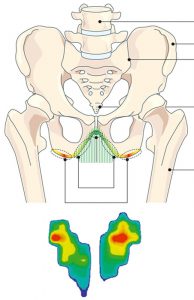
Saddle choice is dependent on muscle structure
The complex structure of the pelvis is held by muscle structures. Muscle approaches are also located on the inside of the ischial tuberosities. If the surface of the saddle is too soft, the saddle padding may form. The resulting hole in the saddle padding sinks the pelvis and ischial tuberosities. The muscle attachments on the inside of the ischial tuberosities are mechanically stressed by friction. It can cause irritation. For frequent travelers, a soft saddle is not the best choice!
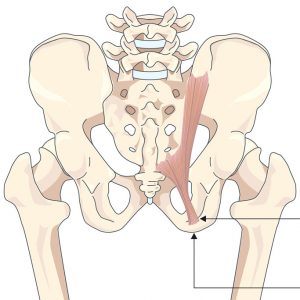
Ergonomic saddles prevent tissue compression
Bicycle saddles with a convex shape compress the tissue area between the ischial tuberosities. The compression of the tissue area can not only be felt, but is also confirmed by pressure measurements. An ergonomic saddle shape reduces avoidable compression formation in the tissue area below the pubic arch.
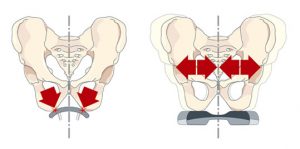
Gender specific frame design
The flatter angle of the female pubic arch touches the saddle nose earlier with the same backward slope. The consequence of this is that women want to sit more upright on the bike. Body Scanning CRM Bike takes these different requirements into account.
The legend in wheel circles, women have longer legs and a shorter upper body, so women’s bicycles must be shorter and provided with a steeper stem, refuted after millions of measurements with Body Scanning CRM. The woman wants to sit upright (shorter) on the bike, because of the different angles of the pubic bones, not because of the probably shorter upper body. Special frame designs for women make sense, but the reason for this is the pubic arch.
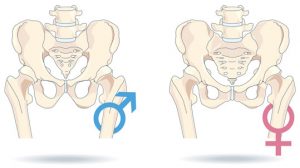
Excursus: Pressure measurement on the bicycle saddle
In the first picture you can see that the saddle selection between the saddle nose and the pubic arch strongly compresses the saddle. Red means very high pressure, blue means very low pressure.
Underneath you can see the pressure reaction of a saddle with a hole in the middle. Pressure is force per unit area. The sides of the hole create areas of high pressure.
The third graphic shows a step saddle from SQ-lab. The red, high pressures are located under the ischial tuberosms, thus the seat reaction forces are introduced via bones into the body of the cyclist without compressing sensitive tissue. Numbness feelings are thus minimized. The burden of the periosteum on the ischial tuberosities is, however, higher.
The source of the information is research results from SQ-lab.
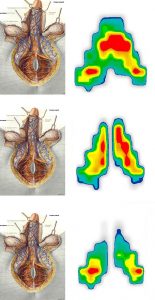
Proper, ergonomic shape and size of the handle can reduce hand and finger problems. The fingers are supplied primarily by two nerves: the ulnar nerve (supplies the two little fingers) and the nerve that passes through the carpal tunnel (supplies the rest of the fingers).
If there is a carpal tunnel syndrome (median compression syndrome), then the angle between hand and forearm should be reduced. This is usually achieved by skillful change of the handle and / or handlebar.
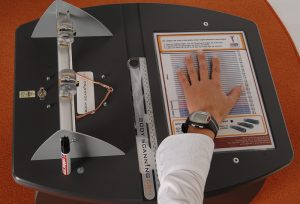
Case Studies
Dealer
Are you a dealer and you want to join our network? Contact us!

